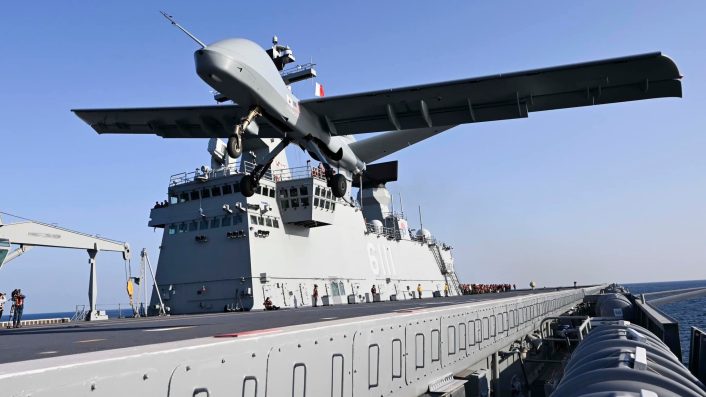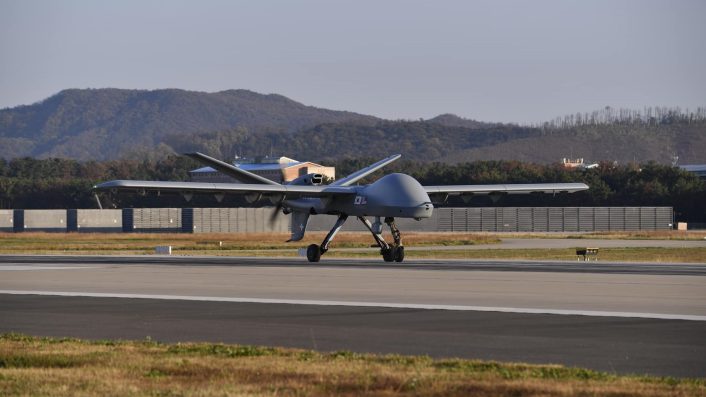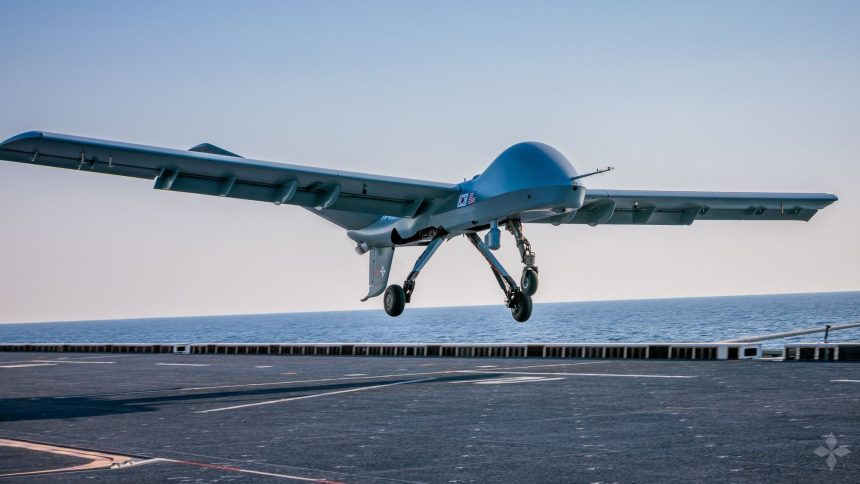The Gray Eagle STOL was transported onto the Dokdo disassembled a week earlier and, after a week of testing, performed the type’s first flight from ship to land. The drone is the production variant of the Mojave demonstrator already tested on the HMS Prince of Wales.
In a first, a GA-ASI (General Atomics Aeronautical Systems) Gray Eagle STOL (Short Take-Off and Landing) unmanned aircraft took off from the RoKN (Republic of Korea Navy) amphibious landing ship Dokdo in the East Sea and landed at an airfield after a hour-long journey on Nov. 12, 2024. The MND (Ministry of National Defense) wanted to evaluate, in what the RoKN described as a “Warfighting Experiment” to test “alternative technology”, the application of “experimental engineering methods to the field of combat development.”
The aircraft safely landed at the Pohang Naval Aviation Command airfield, after maintaining communication with the Dokdo while operating over the sea and then transferring the control to RoKN’s aviation’s ground control. The remote operation was performed by GA-ASI personnel all for the entire duration of the test.
Gray Eagle STOL is the name given to the production variant of the Mojave demonstrator aircraft, says the company, and shares commonality with the baseline Gray Eagle aircraft. It should be noted, however, that the aircraft shows the registration N450MV.
The registration is the same as the Mojave demonstrator which was notably already tested aboard the Royal Navy’s HMS Prince of Wales in 2023. It is not clear which modifications were made to the UAV in addition to the new livery, which by the way also shows US and RoK flags on the fuselage.
“Gray Eagle STOL’s flight proves that navies can add significant new capability without costly major modifications to their existing warships,” said South Korean Chief of Naval Operations, Admiral Yang Yong-mo.
Read here: https://t.co/XSdF4uomc8 pic.twitter.com/IYZxCY0iud
— GA-ASI (@GenAtomics_ASI) November 13, 2024
Gray Eagle STOL has different engines, wings, control surfaces and landing gear, which are modified to obtain much improved STOL performance. The aircraft is the only medium-altitude, long-endurance aircraft of its kind that can operate from large-deck warships such as amphibious ships, aircraft carriers, and unimproved, austere runways and airfields on land.
“The test with the South Korean military further validates the aircraft’s capability and versatility,” GA-ASI said in its statement. The MND, according to GA-ASI, is initially evaluating the drone for its ability to meet emerging military requirements.
The flight
Yoo Yong-won TV published a longer video, showing the Gray Eagle STOL being transported onto the Dokdo in a disassembled form on Nov. 4, 2024. The UAV was put together by a team from GA-ASI and then “underwent test runs for a week,” before the historic test flight from ship to land.

On Nov. 12, the drone was lifted up to the flight deck with the ship’s elevator and took off while the ship was off the coast of Pohang. Before heading to the shore, it flew over the Dokdo ship’s flight deck, and performed a “mock landing maneuver by passing close to the vessel.”
It then comes in to land at the Pohang Naval Aviation Command base. The control of the drone was transferred from the Dokdo to the Naval Aviation Command, and the drone safely landed on the runway of the Pohang Naval Aviation Command. The drone’s remote operators were from General Atomics.
While this was the first such experiment for the South Korean Navy, an earlier flight in Nov. 2023 saw the Mojave demonstrating STOL operations aboard the Royal Navy’s HMS Prince of Wales aircraft carrier. HMS Prince of Wales is smaller than a typical U.S. Navy aircraft carrier, being 932 feet (284 meters) long and 240 feet (73 meters) wide. The Dokdo class is even smaller, with its length and width at 653 feet (199 meters) and 102 feet (31 meters), respectively.
Korea JoongAng Daily defined the Dokdo as essentially a helicopter carrier for amphibious operations, which “suffers from limitations when operating fixed-wing drones.” The RoKN has already operated vertical takeoff and landing UAVs from the Dokdo, said the service.
“The Gray Eagle has a wingspan of 16 meters and a length of 9 meters, and the Dokdo has only 21 meters of deck space where the drone can glide. For this reason, while the drone could take off from the ROKS Dokdo from a complete stop, no landing was attempted during Tuesday’s combat test,” the report added. However, the RoKN only mentioned the length of the deck as a limitation for the operation of the fixed wing Gray Eagle STOL drone.

RoKN’s Chief of Naval Operations Admiral Yang Yong-mo said that the demonstration nevertheless “highlighted the versatility of STOL aboard a warship,” like the Dokdo. “Gray Eagle STOL’s flight proves that navies can add significant new capability without costly major modifications to their existing warships.”
“This demonstration illustrates the ability of the Gray Eagle STOL to safely operate on many types of aircraft-capable ships, which opens myriad new ways our allies can use this UAS to support multi-domain naval operations,” the GA-ASI’s release mentioned quoting its CEO Linden Blue.
Korea’s drones and UCAV plans
The report further added that the RoKN desires a “maritime manned-unmanned composite combat system,” where the uncrewed platforms are “AI-based.” This enables them to build “a solid military readiness posture in a severe security situation and operate unmanned aerial vehicles early.”
The experiment will inform South Korea’s mid to long-term plans to design and build the “ships optimized for fixed-wing unmanned aerial vehicle operation.” The Gray Eagle STOL was “evaluated and selected as an UAV prototype suitable for ship combat tests as it can take off and take off from the short flight deck of a ship less than 100 meters long,” mentioned the RoKN.
Yesterday, Gray Eagle STOL launched from the ROK helicopter ship Dokdo (deck length, 653ft/199m).
GE STOL gets up so quick, we might launch it off surfboards next. 🌊🏄 pic.twitter.com/H8GUuzQPLT
— C. Mark Brinkley (@cmarkbrinkley) November 13, 2024
Brigadier General Kim Byeong-jae, the head of the Naval Power Analysis Test and Evaluation Division said based on the “utility of drones in recent wars […] the Navy is also developing the concept of drone operation in order to establish a solid military readiness posture at sea.” The statement from the service also hinted at establishing a manned-unmanned teaming (MUM-T) capability, developing “the concept of operating unmanned aircraft on ships to strengthen maritime operational capabilities through cooperative operations with manned maritime patrol aircraft.”









